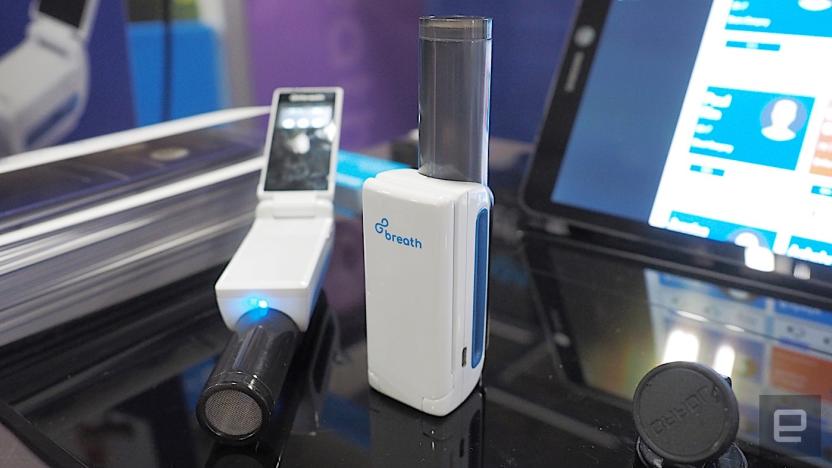lung
Latest

CDC: Vitamin E acetate is 'closely associated’ with vaping lung injuries
For months, the CDC has warned people against vaping until it could determine the cause of a mysterious vaping-related lung injury. Now, the CDC confirms speculation that vitamin E acetate is "closely associated" with EVALI, or e-cigarette, or vaping, product use-associated lung injury.

Vape maker PAX launches PodID to explain what's in your cannabis oil
Consumers want to know what's in the stuff they buy and where it comes from, whether that's food, electricals or clothing -- so why should cannabis be any different? Vape company PAX Labs is rolling out a new feature for its mobile app which gives users detailed information about what makes up their oil concentrate.

CDC confirms 2,051 cases of vaping-related lung injury
The number of vaping-related lung injuries is up to 2,051, the Center for Disease Control (CDC) said in a statement today. Health officials are now referring to the mystery illness as EVALI, short for e-cigarette, or vaping, product use associated lung injury. Cases of EVALI have been reported in 49 states (all but Alaska) and the District of Columbia, and a total of 39 deaths have been confirmed.

CDC warns against vaping until it figures out what’s making people sick
Until the Center for Disease Control can figure out what's causing the mysterious lung illness associated with vaping, it's cautioning people against e-cigs. Last week, it launched a joint investigation with the Food and Drug Administration into a respiratory illness reported after vaping. At the time, it said 215 possible cases had been reported from 25 states, and at least two deaths have been documented. "While this investigation is ongoing, people should consider not using e-cigarette products," the CDC wrote in a press release today.

Scientists successfully transplant lab-grown lungs into pigs
Lab-grown organ transplants aren't right around the corner, but they may considerably closer than you think. University of Texas Medical Branch researchers have successfully tested bioengineered lungs in adult pigs, with no signs of medical complications. While it's not certain how effective the lungs were at oxygenating the pigs, they developed the sturdy network of blood vessels needed to survive. The challenge, as you might guess, was producing a full structure that the pigs' bodies would accept.

GoBreath makes fixing your lung capacity fun
If you have issues with breathing after chest trauma, surgery or anesthesia, then there are breathing exercises designed to help. Normally, your ability to breathe is calculated by using a spirometer, which isn't that interactive -- or accurate. That's what prompted a team of Korean designers to begin working on GoBreath, a digital spirometer that tries to make breathing exercises fun. It's another one of Samsung's C-Lab projects to try and spin out neat product ideas from the Korean behemoth.

Samsung's latest C-Lab projects include private portable speakers
Samsung is making a tradition out of unveiling C-Lab projects at major trade shows, and CES 2018 is no exception. The tech giant is introducing a trio of experiments, starting with its unique S-Ray speaker (above). The makes directional audio portable -- you can listen to your tunes anywhere you go without the potential discomfort of headphones or subjecting everyone to your musical tastes. Samsung is teasing multiple models, including a smartphone cover and a neck-worn speaker that comes across as a less intrusive version of LG's Tone Studio.

Lung-inspired hydrogen fuel cell skimps on platinum, sees efficiency boost
For as spectacular as hydrogen fuel cells are on paper, they haven't been able to replace combustion engines in vehicles. Or much of anything else, really. But thanks to Signe Kjelstrup at the Norwegian Academy of Science and Letters in Oslo, the tried-and-true fuel cell is getting a serious boost. Kjelstrup's crew determined that by using less platinum in a cell, a substantial increase in efficiency and a significant decrease in cost could be achieved. The new design relies on an architecture that's "modeled on the bronchial structure of the lungs to supply hydrogen and oxygen gas to their respective electrodes," which is said to help "spread the gases more uniformly across the catalyst than current channel designs and provides a greater surface area so less platinum is needed." It's still early on in the discovery process, though, and there's certainly no solid word on when this will reach a point where widespread implementation is feasible. Seventh-generation Prius, perhaps?

Rat lungs successfully grown in bioreactor: groundbreaking, yet also kind of gross
Bioartifical organs differ from, well, plain ol' artificial organs because they consist of biomaterials and cells. And while bioartificial livers are becoming increasingly commonplace, it's only recently that working lungs have been grown in a lab. Working at the Massachusetts General Hospital and Harvard Medical School in Boston, researchers removed the left lungs from rats and stripped them of cells with a process that left the blood vessels, airways, and connective tissues intact. Using all that as a sort of scaffolding, lung cells were regrown on the scaffolding in a bioreactor. The cultivation of the lungs took less than a week, and once they'd been run through their paces in culture, they were transplanted into rats. At this point, the lungs did their job for about six hours, after which "they failed through accumulation of fluid inside the lung and resultant capillary leakage," according to PhysOrg. According to the man in charge, Mass General's Harald C. Ott, if work continues at the current pace we might begin to see regenerated organs for human patients within the next ten years. To see the thing in action, hit up that source link.

Researchers create functioning human lung on a microchip
Researchers at Harvard University have successfully created a functioning, respirating human 'lung' on a chip in a lab. Made using human and blood vessel cells and a microchip, the translucent lung is far simpler in terms of observation than traditional, actual human lungs (for obvious reasons), in a small convenient package about the size of a pencil eraser. The researchers have demonstrated its effectiveness and are now moving toward showing its ability to replicate gas exchange between lung cells and the bloodstream. Down the road a bit more, the team hopes to produce other organs on chips, and hook them all up to the already operational heart on a chip. And somewhere in the world, Margaret Atwood and her pigoons are rejoicing, right? Here's to the future. Video description of the device is below.

Haemair envisions external prosthetic lung and respiratory aid
We're not exactly sure how we feel about an external lung (okay, we're completely grossed out, but we're a bunch of pansies when it comes to this stuff anyway), but a Welsh company is looking to introduce one such device in order to aid those with breathing problems. Haemair's Respiratory Aid and Prosthetic Lung would theoretically be worn around the belt and incorporated with a "complete prosthetic lung that will employ no electrical or mechanical parts." By being external, it enables it to be easily maintained, and the simple reversibility is important for "treating emergency and acute cases for which the device might be needed for no more than hours or weeks." As of now, the company is still developing the final product, but just as soon as it can establish that maintenance-free operation is feasible over the long-term, consider the game decidedly "on."[Via medGadget]




